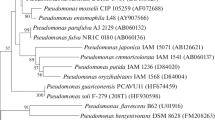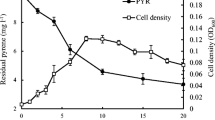Summary
A caffeine-resistant strain of Pseudomonas putida was isolated from soil and was grown with caffeine as the sole source of carbon, energy and nitrogen. Cells were immobilized in agar gel particles which were continuously supplied with a caffeine solution (0.52 g · l−1, D=1.0 h−1) in a homogeneously mixed aerated reaction vessel. In the presence of the ATPase inhibitor arsenate the caffeine was removed by the immobilized cells at an average rate of 0.25 mg caffeine · h−1 · (mg cell carbon)−1 during 6 days. Thereafter a rapid decline of activity was observed. From a similar system without arsenate supplied with a growth medium containing a limiting amount of caffeine (0.13 g · l−1) the caffeine was almost completely oxidized by the immobilized cells. The concentration of the remaining caffeine was 1.4 mg · l−1, which is much lower than the substrate constant for caffeine (9.7 mg · l−1) observed with freshly harvested suspended resting cells.
Similar content being viewed by others
References
Adler ID (1970) In: Chemical Mutagenesis in Mammals and Man. Vogel F, Röhrborn G (eds) Springer, Berlin Heidelberg New York, pp 383–403
Blecher R, Lingens F (1977) The metabolism of caffeine by a Pseudomonas putida strain. Hoppe-Seyler's Z. Physiol Chem 358:807–817
Haas GJ, Stieglitz B (1976) Microbiological decaffeination of aqueous liquids. Canadian Patent No. 1,086,553
Hagan JJ, Dallam RD (1968) Measurement of arginase activity. Anal Biochem 22:518–524
Kihlmann BA (1974) Proceedings of the Symposium on Caffeine as an Environmental mutagen and the Problem of Synergistic Effects. Mutat Res 26:51–155
Kurtzmann RH, Schwimmer S (1971) Caffeine Removal from Growth Media by Microorganisms. Experientia 27:481–482
Middelhoven WJ (1969) Enzyme repression in the arginine pathway of Saccharomyces cerevisiae. Ant v Leeuwenhoek 35: 215–226
Stanier RY, Palleroni NJ, Doudoroff M (1966) The aerobic pseudomonas: a taxonomic study. J Gen Microbiol 43:159–271
Woolfolk CA (1975) Metabolism of N-methylpurines by a Pseudomonas putida strain isolated by enrichment on caffeine as the sole source of carbon and nitrogen. J Bacteriol 123:1088–1106
Author information
Authors and Affiliations
Rights and permissions
About this article
Cite this article
Middelhoven, W.J., Bakker, C.M. Degradation of caffeine by immobilized cells of Pseudomonas putida strain C 3024. European J. Appl. Microbiol. Biotechnol. 15, 214–217 (1982). https://doi.org/10.1007/BF00499958
Received:
Issue Date:
DOI: https://doi.org/10.1007/BF00499958




